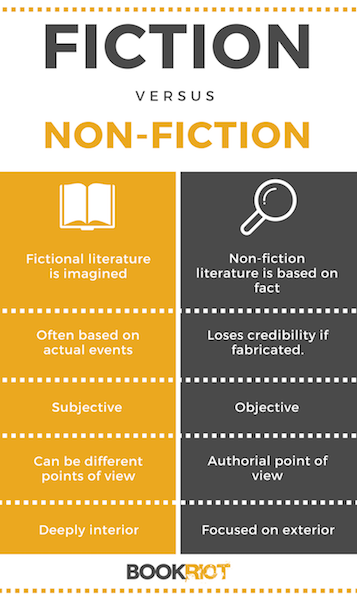A Genre is defined at the style or category of any literary piece, art or music. To understand genres is one of the key requirements of becoming an artist. Once the difference between different genres is clear, it becomes easy for the budding artist to have the light bulb moment and identify the niche which the artist wants to master. The second important aspect of writing is the ‘form of writing’. Often inapt research leads to a confusion between different genres and forms of writing. Therefore, this article will help the new authors understand the difference between these two areas.
Writing comprises many genres. Each genre can further be sub-divided into sub-genres. Therefore, the list is exhaustive. However, we do have a way to simplify this. On the outset, there are two types of genres: Fiction and Non-fiction. The image below will explain the difference between the two:
FICTION
The writing that isn’t based on true facts falls under Fiction. The stories are mostly narrative.
Sub-genres under FICTION:
- Comedy: This is a genre of work that is supposed to be humorous and light. (sub-genres include Anarchic Comedy, Action-Comedy, Black-Comedy, Horror-Comedy, Dramedy, Parody/Spoof, etc)
- Drama: Stories following a continuing narrative and portraying stories of several people who are a part of the plot. (sub-genres include Comedy-drama, Crime drama, Docudrama, Historical Drama, Horror Drama, Legal Drama, Melodrama, Military Drama, Tragedy, etc)
- Horror/ Paranormal: Stories are scary and arouse tension and apprehension. (sub-genres include Gothic Horror, Paranormal Horror, Non-Supernatural Horror, Body Horror, Splatterpunk, Realism)
- Romance: Stories about a romantic relationship between two people (sub-genres include paranormal, historical, contemporary, fantasy, gothic)
- Satire: This is one of the trickiest genres. The stories use either of these four techniques: exaggeration, incongruity, reversal or parody. (sub-genres include Horatian Satire, Juvenalian Satire, Menippean Satire
- Thriller/ Suspense: Stories involve tension and mystery. They are mostly based on pursuit and escape. (sub-genres include Action Thriller, Comedy Thriller, Conspiracy Thriller, Crime Thriller, Erotic Thriller, Giallo, techno-thriller, etc)
- Fantasy: Stories about kingdoms, alternate universe. The stories spend a lot of time on world-building in this genre (sub-genres include High or epic fantasy, Low fantasy, Magical realism, Sword and sorcery, dark fantasy, etc)
- Action-Adventure: Stories that are fast-paced and the physical danger becomes the pivot of the plot.
- Science Fiction: Stories set in past, future or other dimensions fall under this category. (Sub-genres include Alien Invasion, Alternate History (SF), Alternate/Parallel Universe, Apocalyptic/Post-Apocalyptic, Artificial Intelligence, Colonization, Cyberpunk, etc)
- Speculative Fiction. Stories comprise elements or genres that do not exist in the real world. This genre overlaps (in some aspects, with Science Fiction). (sub-genres include Science Fiction, Fantasy, Paranormal/Supernatural, Superhero, Dystopian/Utopian, Post-Apocalyptic/Apocalyptic and Alternate History)
- Young Adult: This genre targets adolescents and young adults. Stories are coming-of-age stories. There are no specific sub-genres in this category. However, the concept of genre-blending (a combination of multiple genres) has become quite famous.
- Historical Fiction: Stories take place against a factual historical backdrop. (sub-genres include Traditional Historical Fiction, Multi-Period Epics, Series, and Sagas, Historical Romantic Fiction, Historical Western Fiction, etc)
- Women’s Fiction: The protagonist of these stories is generally a woman or women who face challenges and difficulties. (sub-genres include Romance)
NON-FICTION
If the writing is not based on concocted story, then it falls under the category of non-fiction.
Sub-genres under NON-FICTION:
- History: true accounts of historical eras and events
- Biographies, autobiographies, and memoirs: focuses on the life story of a particular subject
- Travel guides and travelogues: detail an author’s specific experience travelling somewhere
- Academic texts: to instruct readers on a particular topic
- Philosophy and insight: similar to academic texts and are generally published by university-affiliated publishing houses
- Journalism: encompasses many media
- Self-help and instruction
- Humour and commentary: come under creative nonfiction
TYPES/ FORMS OF WRITING
Writing might seem fun but when it comes to choosing your type, it is a confusing process. Therefore, it is important to understand different forms of writing. I have broken down the various types into bullet points so that it is easier to grasp.
There are majorly four forms of writing: Narrative, Descriptive, Expository and Persuasive.
NARRATIVE WRITING
- Purpose- to tell a story
- Consists of characters, plot, setting, events, conflict and solution
- Follows a chronological order- a story arc (8 steps)
- Eg. Short stories, novels, poetry, autobiographies, biographies, anecdotes
EXPOSITORY WRITING
- Purpose: to explain
- Subject-oriented and thus, contains FACTS and FIGURES
- Doesn’t contain personal opinions
- Follows a logical order and sequence
- Eg. Newspaper and Magazine Articles {not including editorials}, Non-Fiction Books, How-To Books, Self Help Books, Writing about Hobbies & Interests, Recipes & Cookbooks, Instructional Guides, Scientific Research, Manuals, Textbooks & Educational Resources, Business Articles & Books, Medical Research, Journals and Articles
PERSUASIVE WRITING
- Purpose- to convince
- Consists of opinions, reasons, arguments, justifications
- Has a call-to-action approach (urging the readers to do something about the issue)
- Eg.Reviews, cover letters, advertisements, Editorial & Opinion pieces in Newspapers and Magazines, Essays on a specific belief or “hot button” topic, Letters written to request an action or file a complaint, Advertisements {Convincing you to buy something}, Copywriting {Note, copywriting is different from copyright!}, Company Brochures, Business Proposals, Political speeches
DESCRIPTIVE WRITING
- Purpose– to describe
- Often poetic in nature and more expressive
- Uses figurative language
- Eg. Diary/ journal writing, Poetry, Descriptive passages
That’s all, folks! I hope this helps you understand your strength and set achievable goals. I have intentionally not described the genres in detail because that will require an even longer article. So, I shall deal with them in the upcoming chapters. Till then, happy reading!
Ciao!
